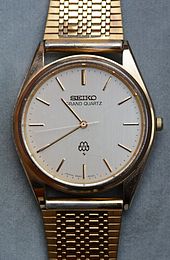Clock failure
The term clock error is understood to mean the deviation of the time indicated by the clock compared to a reference time that is specified by a time standard . This deviation can be constant, steadily increasing or decreasing, or variable.
Clock status: standing fault
A constant deviation over a longer period of time is called the clock status (also: stand error or status ). Basically, the clock runs error-free, only a time that deviates from the desired "target time" (e.g. Central European time ) is set. The algebraic sign of the clock status is generally given in the sense of an improvement to be made. For example, if the clock is 20 seconds behind, the clock reading is + 20s. You have to add 20 seconds to get the correct time.
Clock speed: error in speed
The Uhrgang (also: gear . Umgangspr or accuracy ) refers to a rising or falling deviation of the displayed time in one day. The mean daily rate of a watch can be determined by observing this deviation over a longer period of time .
The difference between the daily deviations from one another, i.e. the fluctuations in the rate of the watch, is called the rate error . A rate error can be due to a defective movement , but it can also be caused by dirt and wear and tear or by external influences such as changes in temperature or air pressure . In the case of pocket watches , the position , i.e. the way the watch is worn, can also have an impact on the daily rate.
For quality tests, these external influences are largely excluded by constant test conditions and testing in different positions . Mechanical watches that have passed a rate test by an official rate control body (e.g. the COSC ) may be called chronometers . The quality feature here is an average daily gait that is as constant as possible, i.e. a low gait error.
In daily use trying for higher quality wheel clocks by compensations compensate for unavoidable external influences. With radio clocks , the rate error only plays a subordinate role, as the correct time is regularly readjusted with the help of a time signal transmitter .
For a short-term response measurement of mechanical watches using a timing machine .
supporting documents
- ^ Karl Giebel, Alfred Helwig : Fine adjustment of the clocks. A guide and reference book; Part I and II . Zentralantiquariat der DDR, Leipzig 1982, ISBN 3-7667-0628-4 (reprint of the Berlin 1952 edition).
